When a particular metric came back lower than desired, the dedicated team of physicians, nurses and office staff at Parkview SurgeryONE didn’t just sit back. They implemented a handful of unique processes to increase overall satisfaction for everyone who comes and goes from their facility. Jeffra Kinniard, BSN, RN, CNOR, ONC, Director of Operations, Parkview SurgeryONE, details this example of true world class teamwork.

For those who aren’t familiar, Parkview SurgeryONE is a 65,000-square-foot free-standing ambulatory surgery center specializing in orthopedics and pain management. For more than 20 years, we’ve worked to provide our surgical patients with the most positive interaction possible. So, when we learned our patient experience scores needed improvement, we gathered our nursing staff, surgical and radiology technologists, clerical staff, and leadership to solicit their input and suggestions. Our key driver was to increase teamwork between doctors, nurses, and staff. The results have been amazing.
The first thing we did was establish Quality Improvement, Safety, and Inservice/Education committees. It is our belief that coworkers who are engaged in decision-making opportunities display greater teamwork, which results in greater quality for the patient.
Next, we initiated the Staff Satisfaction/Engagement committee as a way for coworkers to have an active voice in the surgery center and with each other. It’s important to note the Staff Satisfaction Committee involves no leaders. The group initially met quarterly, but realized they wanted to come together more often as they saw the results of their work. They have implemented wonderful morale boosters for the staff that increased the engagement and overall teamwork in our facility.
 One example of these efforts would be the No BONES About It program. BONES (Building On Excellent Service) allows staff to recognize each other for all of the little and big things they do to go above and beyond. Staff members write something specific about the actions of a coworker on a paper in the shape of a bone (we are an orthopedic surgery center, after all). These are posted to a large bulletin board in the break room. Once a month, all the bones are put in a pile and one is chosen to receive a gift card. Physicians and staff are often huddled around the board to review the most recent recipients of BONES, which has proven to be a great way for the team to show simple appreciation for each other.
One example of these efforts would be the No BONES About It program. BONES (Building On Excellent Service) allows staff to recognize each other for all of the little and big things they do to go above and beyond. Staff members write something specific about the actions of a coworker on a paper in the shape of a bone (we are an orthopedic surgery center, after all). These are posted to a large bulletin board in the break room. Once a month, all the bones are put in a pile and one is chosen to receive a gift card. Physicians and staff are often huddled around the board to review the most recent recipients of BONES, which has proven to be a great way for the team to show simple appreciation for each other.
“We do all sorts of things with our staff to keep morale boosted and people engaged in our facility. This includes fun games and carry-ins,” Stacie Lovellette, C.S.T., Parkview SurgeryONE, said. As committee chair, Stacie has seen the power of positivity. “We have a TOP DOG program to get to know more about our coworkers. They become a star of the month, with their picture and a questionnaire full of fun facts. This has helped us become better coworkers and friends by getting to know each other more personally. This combined with our No BONES About It program enables us to recognize each other for all the great things we do as a team. We appreciate each other more.
Our patients see these relationships and they can truly tell we enjoy working together. It makes them feel more at ease. From the time the patient enters our facility until they leave, they know we will be able to communicate to each other and help them with all of their needs. Our satisfaction scores are extremely high because of it.”
The committee has also started a program called Passport, which allows all staff to shadow the process that a patient goes through from scheduling to dismissal. “Of all the programs we’ve introduced, the most significant change has been a better understanding of how each of our jobs are connected,” Stacie said. “Through Passport, we’ve learned more about each other’s job duties and developed a better understanding and respect for what everyone does here.” This promotes further understanding, appreciation, and respect for the role of each member of the team and how they affect the patient experience. It’s increased staff willingness to work together for a common goal — a happy patient. In turn, it is easy to see why the teamwork score has risen based on this initiative alone.
“I recently went through the Passport program, and not only did it help to see the entire process and what all my coworkers do, it also helped me better educate my patients regarding their preoperative, operative and postoperative education and expectations,” Lori Toth, RN, surgical care coordinator, said. “It helped me appreciate all that everyone does and how their job function fits in to improve patient care.”
The Safety and Quality Improvement committees revised the safe surgery checklist, which is a communication tool to assist with patient handoff throughout the patient’s journey. The main goal here is to enhance patient safety. For the patient, this has meant more involvement, understanding, and confidence in their care.
The Education/Inservice committee organized IRELATE training. IRELATE stands for Introduce, Reassure, Explain, Listen, Answer, Take Action, and Express Appreciation. Staff has taken care to tailor the principles specifically to the surgery center, and review the concepts regularly at staff meetings. This activity generated a lot of conversation about best practices in communicating with patients and narrating care. Emphasis was placed on providing better explanations of why specific activities were being performed with the patient, which increased patient understanding and confidence in their care providers.
“As a team member, to me, IRELATE means that I will take the time to engage with my patient by not talking to them, but talking with them,” Michelle Apt, RN Nurse Leader, registration supervisor, Parkview SurgeryONE, said. “It’s about introducing myself while making eye contact with the patient and letting them know they have your full attention. Then you narrate your care. The patient often has no idea what is going to happen next. By narrating your care you are reducing anxiety so the patient doesn’t have to wonder what the next step is going to be. It means I will also empathize with my patient, listen, and address their concerns and thank them for voicing those concerns.
I like the fact that by using IRELATE, my patient is informed and aware of the next steps in the process. Plus, they feel welcome to ask questions. I sincerely hope they will feel that I have their best interests at heart based on my responses to them. Having a surgery is a scary time for most people. I feel like using IRELATE helps put them at ease.”
The continuous focus and discussion of the principles of IRELATE allowed our nursing staff to examine every patient interaction, including post-op phone calls. There are many examples of the staff’s creativity in this area, but there is one that demonstrates how well we have embedded the patient care experience into our everyday culture.
The mother of a young patient had questions about the proper application of a shoulder immobilizer when the nursing staff called her on post-op day one. The mother had received detailed education utilizing the teach back method and had written instructions on the application of the device. However, when the mother removed the immobilizer so the patient could perform self-care, she was concerned that she had not re-applied it correctly. The nursing staff provided direction over the phone but the mother was still unsure. The patient’s home was 45 minutes from our facility and the mother asked if she could return to the center for assistance. One nurse had the idea to use cell phones to communicate. They made an instructional video on their cell phone and texted it to the mother. This provided step-by-step directions that the mother and patient could utilize throughout his recovery. The mother was thrilled and texted a photo of the patient wearing the immobilizer correctly with a big smile on her face.
Patient Experience/Satisfaction data is shared at our weekly leadership meetings. Because leadership begins each week with the most updated information, it sets the tone for the entire week. It is also a standing agenda item on all supervisor meetings with staff and on the huddle boards in each department. There are at least six other bulletin boards throughout the facility where the data is posted weekly. The Patient Experience “Champion” for our facility shares feedback from our surveys on a weekly basis. If there is disappointing or exceptional feedback, the chart is reviewed and the information is shared with the involved staff directly. This allows us to celebrate our successes and gives us an opportunity to change processes or behaviors before they become a bad habit.
Through these programs, not only did we enhance our Overall Quality of Care score, but our staff also became more engaged. We currently rank in the 99th percentile for teamwork. The entire team pulled together to make our patients’ experiences exceptional and we work to maintain this level of care every single day.



